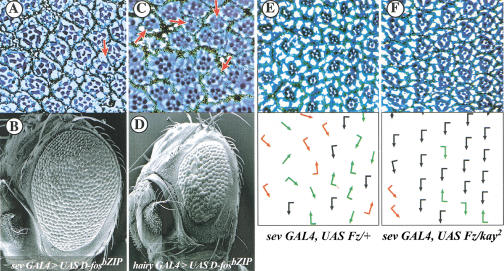Figure 5.
D-Fos is an effector of both JNK and ERK pathways in the eye. Tangential eye sections of adult eyes of the genotypes sev GAL4 > UAS fosbZIP and hairy GAL4 > UAS fosbZIP (A and C) and corresponding scanning electron micrographs (B and D). (A) At the cellular level both photoreceptor recruitment (examples of ommatidia with less than seven photoreceptors are indicated by red arrows) and planar polarity (note the general misoriented organization of the ommatidia) are affected. (B and D) The expression of the mutant form of D-Fos in the eye causes external roughness. Note that the effect is stronger and accompanied by a reduced eye size when D-FosbZIP is under the control of the hairy GAL4 driver. This driver is active transiently during eye imaginal disc development, in all cells immediately anterior to the morphogenetic furrow, and in the presumptive R7 photoreceptor cells of the developing ommatidia (Brown et al. 1991), whereas the sev GAL4 driver is active mainly in the R7, 3, and 4 precursor cells. (E and F) Eye sections (top) and schematic representations (bottom), with arrows reflecting ommatidial planar polarity. (Black arrows) Correct ommatidial orientation; (red arrows) misrotated ommatidia with correct chirality; (green arrows) opposite chirality for the respective eye field; (arrows without flag) symmetrical nonchiral ommatidia. The disorganized appearance because of the overactivation of the planar polarity signaling cascade by sev GAL4, UAS Fz/+ (E) is suppressed dominantly by kay2 heterozygosity (F).

